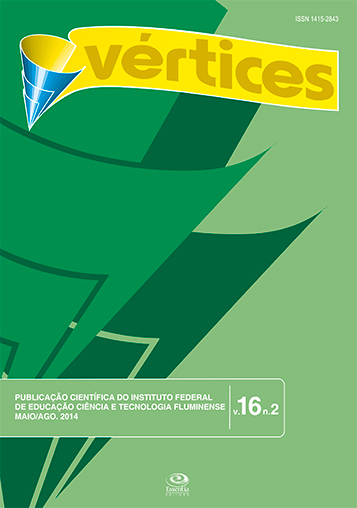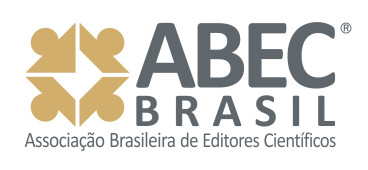Geoprocessamento aplicado à análise espacial e temporal de ecossistemas aquáticos como uma ferramenta para o ensino de Ciências
DOI:
https://doi.org/10.5935/1809-2667.20140016Palavras-chave:
Análise ambiental, Aprendizagem participativa, Ensino de Ciências, Geoprocessamento, TecnologiaResumo
As novas tecnologias fazem parte da vida moderna, e sua aplicação no processo educacional básico constitui uma demanda importante dos programas de educação vigentes. No campo das ciências, essa estratégia é fundamental para a construção de um estudante inquisitivo, o que forma a base para o desenvolvimento de um processo efetivo de aprendizagem. Este trabalho apresenta uma técnica de geoprocessamento que visa auxiliar professores e estudantes de escolas básicas e secundárias nos campos de ciências, biologia e geografia a desenvolverem habilidades para análise ambiental objetivando um aprendizado participativo.Downloads
Referências
ALBERTONI, E. F.; PALMA-SILVA, C.; ESTEVES, F. A. Macroinvertebrates associated with Chara in a tropical coastal lagoon (Imboassica lagoon, Rio de Janeiro, Brazil). Hydrobiologia, v. 457, p. 215-224, 2001.
BARNES, J. Cross-curricular learning. London: SAGE, 2011.
BIDEGAIN, P.; BIZERRIL, C.; SOFFIATI, A. Lagoas do Norte Fluminense: perfil ambiental. Rio de Janeiro: SERLA, 2002.
BIZERRIL, M. X. A. Children’s perceptions of Brazilian Cerrado landscape and biodiversity. The Journal of Environmental Education, v. 35, n. 4, p. 47-58, 2004.
BRADLEY, D. J.; BARTRAM, J. K. Domestic water and sanitation as water security: monitoring, concepts and strategy. Philosophical transactions of the royal society A, v. 371, 10120420, 2013.
BRASIL. Lei de diretrizes e bases da educação: lei n. 9.394/96. Brasília: DP&A, 2000.
BRASIL. Parâmetros Curriculares Nacionais: Ciências Naturais. Brasília: MEC, Secretaria do Ensino Médio, 1998.
BYBEE, R. W. Teaching science as inquiry. In: MINSTRELL, J.; VAN ZEE, E. Inquiring into inquiry learning and teaching in science. Washington: American Association for the Advancement of Science, p. 21-46, 2000.
CARO, T. M.; PELKEY, N.; GRIGIONE, N. Effects of conservation biology education on attitudes toward nature. Conservation Biology, v. 8, n. 3, p. 846-852, 1994.
DUCKWORTH, E. “The having of wonderful ideas” and other essays on teaching and learning. New York: Teachers College Press, 1978.
DWYER, C. A. Using emerging technologies to construct effective learning environments. Educational Media International, v. 36, n. 4, p. 300-309, 1999.
GATTS, C. E. et al. On the use of photothermal techniques for monitoring constructed wetlands. Review of Scientific Instruments, v. 74, p. 510-512, 2003.
GOMES, S. A. A importância das áreas alagáveis para a região Norte Fluminense e a abordagem desse tema nos livros didáticos do Ensino Médio. Undergraduation Thesis (Licenciatura em Ciências Biológicas) – Universidade Estadual do Norte Fluminense, Campos dos Goytacazes, 2004.
GOMES, M. A. C.; SUZUKI, M. S. Aspectos ambientais e históricos da Lagoa do Campelo. Perspectivas online, v. 2, n. 7, p. 140-151, 2008.
GOUDIE, A. Characterising the distribution and morphology of creeks and pans on salt marshes in England and Wales using Google Earth. Estuarine, Coastal and Shelf Science, v. 129, p. 112-123, 2013.
GOUW, A. M. S., FRANZOLIN, F.; FEJES, M. E. Desafios enfrentados por professores na implementação de atividades investigativas nas aulas de ciências. Ciência & Educação, v. 19, n. 2, p. 439-454, 2013.
HAWKINS, D. The informed vision: Essays on learning and human nature. New York: Agathon Press, 1974.
INSTITUTE FOR THE TRANSFER OF TECHNOLOGY TO EDUCATION, NATIONAL SCHOOL BOARDS ASSOCIATION. Education leadership toolkit: Change and technology in America’s schools. Available at: <http://www.nsba.org/sbot/toolkit/tiol.html>. Access in: 26 mar. 2008.
INSTITUTO NACIONAL DE PESQUISAS ESPACIAIS (Brasil). [Imagens]. [S. l.: S. n.: 2013]. Available at: <http://satelite.cptec.inpe.br/home/novoSite/index.jsp?i=br>. Access in: 26 nov. 2013.
JERKINS, A.; PEPPER, D. Enhancing students’ employability and self-expression: how to teach oral and groupwork skills in geography. Journal of Geography in Higher Education, v. 12, n. 1, p. 67-83, 1988.
JORDAN, W. R.; FOLLMAN, J. M. Using technology to improve teaching and learning: Hot topics: Usable research. (ERIC Document Reproduction Service No. ED355930). [S. l.: S. n.]: 1993.
KERR, S. P. Technology, teachers, and the search for school reform. Educational Technology, Research and Development, v. 37, n. 4, p. 5-17, 1989.
KRASILCHIK, M. Reformas e realidade: o caso do ensino de ciências. São Paulo em Perspectiva, São Paulo, v. 14, n. 1, p. 85-93, 2000.
LANNES, L. S. Hidroquímica do sistema alagado urbano Vigário-Taquaruçu, Campos dos Goytacazes, RJ. Undergraduation Thesis (Bacharelado em Ciências Biológicas) – Universidade Estadual do Norte Fluminense, Campos dos Goytacazes, 2002.
LINN, M. C.; HSI, S. Computers, teachers, peers: Science learning partners. New Jersey: Lawrence Erlbaum Associates, 2009.
MACAGNAN, I. R. Utilizando Sistemas de Informação Geográfica na Escola. In: COLOQUIO DE CARTOGRAFIA PARA ESCOLARES, 4, 2001, Maringá. Anais... Maringá: [S. n.: 2001?].
MITSCH, W. J.; GOSSELINK, J. G. Wetlands. New York: John Wiley & Sons, 2000. MOSSA, J. Participatory student field guides and excursions. Journal of Geography in Higher Education, v. 19, n. 1, p. 83-90, 1995.
NATIONAL RESEARCH COUNCIL. National science education standards. Washington: National Academy Press, 2000.
PALMER, J. A.; BIRCH, J. C. Geography in the Early Years. New York: Routledge Falmer, 2004.
SANTOS, J. M.; LAHM, R. A; BORGES, R. M. R. O Sensoriamento Remoto como recurso para a educação científica e tecnológica. In: Borges, R. M. R; Basso, N. R.; Rocha Filho, J. B. Propostas Interativas na Educação Científica e Tecnológica. Porto Alegre: EDIPUCRS, 2008.
SHAPIRO, B. A collaborative approach to help novice science teachers reflect on changes in their construction of the role of science teacher. Alberta Journal of Educational Research, v. 7, p. 119-132, 1991.
SHAPIRO, B. A case study of change in elementary student teacher thinking during an independent investigation in science: learning about the “face of science that does not yet know”. Science Education, v. 80, n. 5, p. 535-560, 1996.
SHARP, N. How to teach oral and groupwork skills in geography. Journal of Geography in Higher Education, v. 13, n. 2, p. 207-209, 1989.
TEDESCO, J. C. (Org.). Educação e novas tecnologias: esperança ou incerteza? São Paulo: Cortez, 2004.
TYLER, R. Independent research projects in school science: Case studies of autonomous behavior. International Journal of Science Education, v. 14, p. 393-411, 1992.
VIANNA, M. S. R. Salubridade domiciliar: uma discussão sobre o saneamento básico nas favelas do município do Rio de Janeiro. Master’s thesis (Escola Nacional de Saúde Pública) – Fiocruz, Rio de Janeiro, 1991.
WELCH, W. W. et al. The role of inquiry in science education: analysis and recommendations. Science Education, v. 65, n. 1, p. 33-50, 1981.
YU, L; GONG, P. Google Earth as a virtual globe tool for Earth science applications at the global scale: progress and perspectives. International Journal of Remote Sensing, v. 33, n. 12, p. 3966-3986, 2012.
Downloads
Publicado
Edição
Seção
Licença
Os autores do manuscrito submetido à revista Vértices, representados aqui pelo autor correspondente, concordam com os seguintes termos:
Os autores mantêm os direitos autorais e concedem sem ônus financeiro à revista Vértices o direito de primeira publicação.
Simultaneamente o trabalho está licenciado sob a Licença Creative Commons Atribuição 4.0 Internacional (CC BY 4.0), que permite copiar e redistribuir os trabalhos por qualquer meio ou formato, e também para, tendo como base o seu conteúdo, reutilizar, transformar ou criar, com propósitos legais, até comerciais, desde que citada a fonte.
Os autores não receberão nenhuma retribuição material pelo manuscrito e a Essentia Editora irá disponibilizá-lo on-line no modo Open Access, mediante sistema próprio ou de outros bancos de dados.
Os autores têm autorização para assumir contratos adicionais separadamente, para distribuição não exclusiva da versão do trabalho publicada na revista Vértices (ex.: publicar em repositório institucional ou como capítulo de livro), com reconhecimento de autoria e publicação inicial neste periódico.
Os autores têm permissão e são estimulados a divulgar e distribuir seu trabalho online na versão final (posprint) publicada pela revista Vértices em diferentes fontes de informação (ex.: em repositórios institucionais ou na sua página pessoal) a qualquer tempo posterior à primeira publicação do artigo.
A Essentia Editora poderá efetuar, nos originais, alterações de ordem normativa, ortográfica e gramatical, com o intuito de manter o padrão culto da língua, contando com a anuência final dos autores.
As opiniões emitidas no manuscrito são de exclusiva responsabilidade do(s) autor(es).























1.png)



